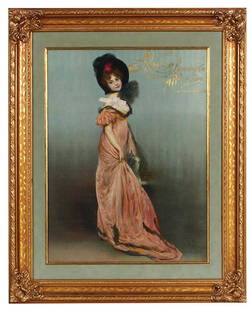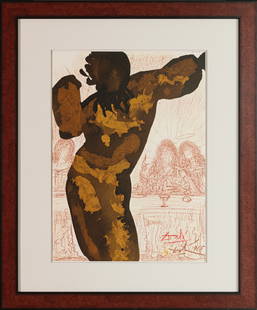
GEORGE SENSENEY (1874-1943 Washington DC) Spanish Woman
Similar Sale History
View More Items in Prints & Multiples
Related Prints & Multiples
More Items in Art Deco Prints & Multiples
View MoreRecommended Art
View More




Item Details
Description
Ashcan school. "Spanish Woman" Pencil signed etching. Portrait of an early 20th century woman.11 3/4 x 8 3/4 in. (plate). 18 1/2 x 14 1/2 in. (framed). From a prominent family in Wheeling, West Virginia, George Senseney became known for his printmaking abilities with color, especially with lithographs and wood blocks. Also, he laid the technical foundation, which led to the production of much decorative paper. He attended the public schools in his birthplace of Wheeling and also Linsley Military Academy. For his art training he studied in Washington DC in the Corcoran School of Art; took private with Howard Helmick, a prominent DC artist, and in 1899, went to Paris where he studied with Jean Paul Laurens and Benjamin Constant at the Academie Julian. In 1901, he entered work in the Paris Salon.Returning to the United States, he became the first artist in this country to practice color etching, something that was being done in France. For this process, he made his own inks. A reviewer in the New York Times wrote about Senseney's unique colored prints exhibited at Keppel Galleries: "Until the public is more familiar with the colored prints of modern times, we cannot too much insist up their autographic character. Each print is as much a picture by the artist as though to make it he had used oil or water color pigment. . . . In the case of Mr. Senseney, he uses a copper plate of soft ground, makes his drawing on this with his etching needle, the inks his plate with inks of different colors and prints, often varying his color scheme several times before deciding upon one from which to make the majority of his impressions. No impression can be precisely like any other, the plate requiring a separate inking for each. The result represents the artists' own feeling for form, color, and texture, as the work in nearly all cases is done from nature and not from the paintings of others". The effect is extremely pleasing, have a quiet and gentle sentiment that suggest the landscapes of the milder members of the Barbizon school." (June 21, 1908).He taught etching at the Art Students League in New York from 1906-1907; then returned to France from 1910 to 1914, and did the work that led to his processes to make the decorative paper. In 1911, he became a member in France of the Societé des Graveurs Original en Couleurs, only one of two non-French members.In Chicago, he established the New School of Art with Frederick Fursman, and in 1915, was elected President of the Chicago Society of Etchers. Two years later, he began four years of teaching Design at Smith College, and became Art Director in Holyoke, Massachusetts for the American Writing Paper Company. There he developed a process for marbling papers. In 1915, he also earned a silver medal for etching at the Panama-Pacific Exposition in San Francisco.Six years later he and several other fellow employees left that company and formed the Marvellum Company of Holyoke, the first company to create marbled paper by machines. He remained with this company for the remainder of his career, and acquired numerous patents including for textile printing. One of his inventions is called the "Sensagraph Process" and is effective for printing designs on silks. In a history of his family, whose name in Virginia was sometimes spelled Sensiney, it was boasted that "he knows more about various processes of printing than any other man alive, in that he can engrave and etch printing rolls, and is constantly doing so, and makes inks and colors for all classes of printing. There are experts in Lithography, Photoengraving, Embossing, Rotogravure, Offset Printing, etc., but as a rule they know their own particular process. He has a working knowledge of practically all the processes, which he has put into practical manufacturing, designing machines for the same, making colors, and engraved rolls for the same. George has accomplished his great work under handicap. He has been lame on account of infantile paralysis when eighteen months of age. All of the big "Sensiney" family can well be proud of numbering George Eyster Senseney among our cousins." (Sensenig)In November 1943, George Senseney died at age 69 in Ipswich, Massachusetts, having been ill for four years. His wife, Dorothy Stewart Senseny, survived him.Sources:Barton Sensenig, Sensineys in America, 1943http://www.rootsweb.com/~wvwags/gsenseney.htm (Includes The New York Times references)
Condition
Toning in the margins, the folio is in good condition
Buyer's Premium
- 25%
GEORGE SENSENEY (1874-1943 Washington DC) Spanish Woman
Estimate $400 - $600
11 bidders are watching this item.
Shipping & Pickup Options
Item located in Margate City, NJ, usOffers In-House Shipping
Local Pickup Available
Payment

TOP











































![Irving Penn, Platinum Prints [SIGNED - 2005 1ST EDITION - FINE]: National Gallery of Art & Yale University Press, Washington DC & New Haven, 2005. First edition, first printing (with a full numberline ending in 1). 12 x 9.5 inches. 190 pages with numerous photograp](https://p1.liveauctioneers.com/8658/325945/175539629_1_x.jpg?height=310&quality=70&version=1712964944)







































